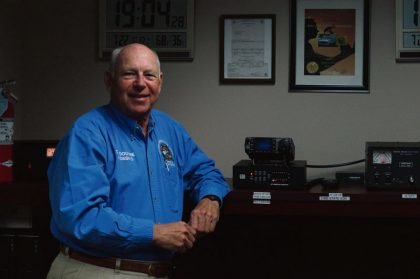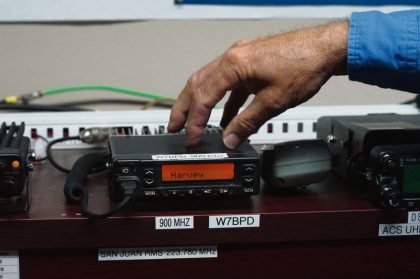 ACS Manager Chris Doutre stands next to his favorite worldwide radio in the Emergency Operations Center, more commonly known as the radio room, in the Blaine Police Department. Photo by Sarah Sharp.
ACS Manager Chris Doutre stands next to his favorite worldwide radio in the Emergency Operations Center, more commonly known as the radio room, in the Blaine Police Department. Photo by Sarah Sharp.
By Sarah Sharp
When the deadliest landslide in American history swept Oso two years ago, amateur ham radio operators from Blaine volunteered their skills to save lives.
Members of Blaine’s Auxiliary Communications Service (ACS) spent 172 hours on duty at the Snohomish County Emergency Operations Center and Darrington Command Vehicle. They reported safety issues, injuries and work stoppages on the scene and created a backup communications network where the landslide had cut Internet and phone service, said Scott Honaker, the Snohomish County communications coordinator.
Each amateur radio operator who participated in the Highway 530 response was awarded for his or her volunteer service, and about half of them came from Whatcom County, Honaker said. Each operator received a pin embossed with a view of the landslide and memorial tree at the 2015 communications academy.
The Oso tragedy revealed a sobering truth: ordinary communication networks can fail in crises – and when they do, ham radio operators are an invaluable asset. But for most, ham radio is a hobby – testing the limits of the technology, communicating with other amateur radio operators around the globe or even racking up their number of contacts to score titles in contests.
 Doutre points out one of the department’s radios in the radio room. Photo by Sarah Sharp.
Doutre points out one of the department’s radios in the radio room. Photo by Sarah Sharp.
Then there are the “hams,” as they call themselves, who utilize the technology for community service.
“Every ham isn’t an emergency services guy, but many emergency services communicators are ham operators,” ACS member Bill Bullock said.
Not to be confused with a club, ACS is the volunteer arm of the Blaine Police Department. Blaine police chief Mike Haslip, who cofounded the service a decade ago, likens it to the United States Coast Guard Auxiliary or the Civil Air Patrol.
According to the American Radio Relay League, there are 154 registered hams in Blaine. Twenty-three of them belong to ACS. Membership is by invitation only, and prospective members must pass a thorough background check before they can be accepted.
ACS founders first imagined the potential for a volunteer communications service when the department was considering the daunting task of communicating with other agencies in the case of a crisis, Haslip said.
Now, a line of antennas atop the roof of the Blaine Police Department provide a hint of what’s inside. The Emergency Operations Center, more commonly known as the radio room, contains myriad radios – some with powerful worldwide capabilities and some that connect to the fire department, sheriff’s office, Camp Murray, public works and about anywhere else you can imagine.
ACS members also occupy their own space at the former Blaine airport hanger, where they gather for monthly meetings and park their mobile radio room, a converted ambulance they purchased for $1 from North Whatcom Fire and Rescue.
Each ACS member owns their own radio and donates anywhere from two to 100 hours a month of community service to the city, ACS manager Chris Doutre said. They’re the people clad in yellow vests clutching radios every year at Blaine’s Fourth of July Celebration, the Ragnar Relay Race and the Christmas Tree Lighting ceremony. They provide traffic control when streets close, back-up assistance when Blaine police are short-handed and preparation in the event of long-term emergencies, Haslip said.
“We wouldn’t have [those events] if it weren’t for people like [Doutre] donating so many hours a month or [Bullock] taking off his traffic engineer hat and putting on his ACS volunteer hat,” he said.
Although ACS’ services meet a recurring need in the city’s event planning, the group sees events such as the Fourth of July as opportunities to both serve their community and train for emergencies.
“Yes, we’re executing a traffic control plan or a crowd control plan, but it’s all training for when an earthquake or the landslide in Oso happens,” Bullock said.
The ACS motto cautions, “Don’t be a victim.” And so they’ve already got a plan for when the “Big One,” the massive earthquake projected in Cascadia, hits Blaine. Doutre said as soon as they feel the ground shake, they’ll switch on their radios.
“Whether you have a handheld radio or a full-fledged powerful base radio, you turn it on and announce you’re there,” he said, adding, “Everyone else will do the same, and next thing you know, we’ll be having discussions about who can come to the police station, who cannot, who needs help and who can help.”
Ensuring the safety of their own families comes first, Bullock said. Then, they’ll deploy themselves to look out for their neighbors and assess how they can serve the Blaine Police Department.
“We would talk to the chief, and the chief would say, ‘This is what we need,’” Doutre said.
He recognizes amateur radio as a responsibility, one that must not be taken for granted. That’s where the tradition of hams aiding in disaster relief comes from, Doutre said.
“OK, amateur radio operators, you are using a very precious resource [radio waves], so the government, your community, your country expects you to be ready to help in an emergency,” he said. “I think that’s a fair trade.”
The keepers of this precious resource span generations and continents. It’s a worldwide hobby that’s often passed down by fathers and grandfathers hoping to keep the tradition alive for the next generation, Doutre said. His father and father-in-law were both ham radio operators, and Doutre eventually used the skills they taught him to sail across the Pacific Ocean as an amateur radio operator. Haslip built his own radio back in the day, and Bullock has already passed the antennas on to his son, who became licensed at the age of 12.
Many amateur radio buffs use the technology to communicate with fellow hams across the globe. Most use English, and the conversation typically follows a predictable set of questions: “Who are you? Where are you? How’s it going? What kind of radio are you using? What kind of antenna? How’s your signal strength?”
To bid goodbye, Doutre will rattle off: “This is KG6SKO. Clear. Have a good day.”
For information about joining ACS, contact Doutre at at kg6sko@arrl.net.
Comments
No comments on this item Please log in to comment by clicking here